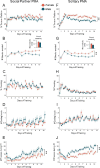This is a preprint.
Active avoidance recruits the anterior cingulate cortex regardless of social context in male and female rats
- PMID: 38260416
- PMCID: PMC10802695
- DOI: 10.21203/rs.3.rs-3750422/v2
Active avoidance recruits the anterior cingulate cortex regardless of social context in male and female rats
Update in
-
Social context modulates active avoidance: Contributions of the anterior cingulate cortex in male and female rats.Neurobiol Stress. 2024 Dec 5;34:100702. doi: 10.1016/j.ynstr.2024.100702. eCollection 2025 Jan. Neurobiol Stress. 2024. PMID: 39737250 Free PMC article.
Abstract
Actively avoiding danger is necessary for survival. Most research has focused on the behavioral and neurobiological processes when individuals avoid danger alone, under solitary conditions. Therefore, little is known about how social context affects active avoidance. Using a modified version of the platform-mediated avoidance task in rats, we investigated whether the presence of a social partner attenuates conditioned freezing and enhances avoidance learning compared to avoidance learned under solitary conditions. Rats spent a similar percentage of time avoiding during the tone under both conditions; however, rats trained under social conditions exhibited greater freezing during the tone as well as lower rates of darting and food seeking compared to solitary rats. Under solitary conditions, we observed higher levels of avoidance in females compared to males, which was not present in rats trained under social conditions. To gain greater mechanistic insight, we optogenetically inactivated glutamatergic projection neurons in the anterior cingulate cortex (ACC) following avoidance training. Photoinactivation of ACC neurons reduced expression of avoidance under social conditions both in the presence and absence of the partner. Under solitary conditions, photoinactivation of ACC delayed avoidance in males but blocked avoidance in females. Our findings suggest that avoidance is mediated by the ACC, regardless of social context, and may be dysfunctional in those suffering from trauma-related disorders. Furthermore, sex differences in prefrontal circuits mediating active avoidance warrant further investigation, given that females experience a higher risk of developing anxiety disorders.
Keywords: fear; optogenetics; prefrontal cortex; sex differences.
Conflict of interest statement
Declaration of interests The authors declare that no competing interests exist.
Figures





Similar articles
-
Social context modulates active avoidance: Contributions of the anterior cingulate cortex in male and female rats.Neurobiol Stress. 2024 Dec 5;34:100702. doi: 10.1016/j.ynstr.2024.100702. eCollection 2025 Jan. Neurobiol Stress. 2024. PMID: 39737250 Free PMC article.
-
Active avoidance requires inhibitory signaling in the rodent prelimbic prefrontal cortex.Elife. 2018 May 31;7:e34657. doi: 10.7554/eLife.34657. Elife. 2018. PMID: 29851381 Free PMC article.
-
Paired-housing selectively facilitates within-session extinction of avoidance behavior, and increases c-Fos expression in the medial prefrontal cortex, in anxiety vulnerable Wistar-Kyoto rats.Physiol Behav. 2016 Oct 1;164(Pt A):198-206. doi: 10.1016/j.physbeh.2016.05.044. Epub 2016 May 24. Physiol Behav. 2016. PMID: 27235339
-
Acute stress yields a sex-dependent facilitation of signaled active avoidance in rats.Neurobiol Stress. 2024 Jun 13;31:100656. doi: 10.1016/j.ynstr.2024.100656. eCollection 2024 Jul. Neurobiol Stress. 2024. PMID: 38994219 Free PMC article. Review.
-
Conserved features of anterior cingulate networks support observational learning across species.Neurosci Biobehav Rev. 2019 Dec;107:215-228. doi: 10.1016/j.neubiorev.2019.09.009. Epub 2019 Sep 8. Neurosci Biobehav Rev. 2019. PMID: 31509768 Free PMC article. Review.
References
-
- American Psychiatric Association. (2013). Diagnostic and statistical manual of mental disorders : DSM-5 (5th ed.). American Psychiatric Association.
Publication types
Grants and funding
LinkOut - more resources
Full Text Sources

